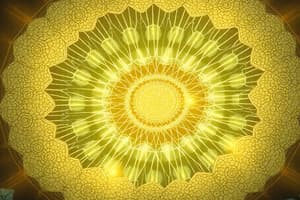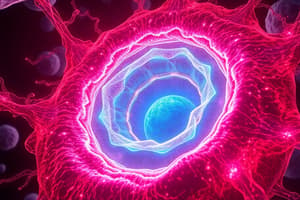Podcast
Questions and Answers
What is the primary function of the nuclear lamina?
What is the primary function of the nuclear lamina?
- To synthesize proteins
- To regulate transcription of mRNA
- To store DNA and RNA
- To provide structural support to the nuclear envelope (correct)
Which of the following correctly describes the nuclear envelope?
Which of the following correctly describes the nuclear envelope?
- Formed by a network of protein filaments
- Contains a space that is 10-20nm wide
- Is continuous with the endoplasmic reticulum (correct)
- A single-layered membrane surrounding the nucleus
How do genetic mutations related to the nuclear lamina affect individuals?
How do genetic mutations related to the nuclear lamina affect individuals?
- They can lead to enhanced cell division
- They improve the structural integrity of the nucleus
- They enhance the transcription of mRNA
- They may cause progeria syndrome (correct)
What is the significance of nuclear pores in the cell nucleus?
What is the significance of nuclear pores in the cell nucleus?
What is a characteristic of the chromatin found within the nucleus?
What is a characteristic of the chromatin found within the nucleus?
What is the primary function of the nuclear pore complex?
What is the primary function of the nuclear pore complex?
Which of the following molecules can pass through the nuclear pore complex?
Which of the following molecules can pass through the nuclear pore complex?
What is the diameter of the channel in the central zone of the nuclear pore complex?
What is the diameter of the channel in the central zone of the nuclear pore complex?
What is the substance surrounding the chromosomes and nucleoli in the nucleus called?
What is the substance surrounding the chromosomes and nucleoli in the nucleus called?
Which component is NOT typically found dissolved in the nucleoplasm?
Which component is NOT typically found dissolved in the nucleoplasm?
What characteristic distinguishes integral membrane proteins from peripheral proteins?
What characteristic distinguishes integral membrane proteins from peripheral proteins?
Which mechanism explains the movement of water and charged inorganic ions across membranes?
Which mechanism explains the movement of water and charged inorganic ions across membranes?
What is a key function of the nucleus in eukaryotic cells?
What is a key function of the nucleus in eukaryotic cells?
Which type of integral membrane protein spans the entire plasma membrane and can act as a transporter?
Which type of integral membrane protein spans the entire plasma membrane and can act as a transporter?
What makes the inner face of the plasma membrane more fluid compared to the outer layer?
What makes the inner face of the plasma membrane more fluid compared to the outer layer?
Which type of cells in the human body lack a nucleus?
Which type of cells in the human body lack a nucleus?
Which of these proteins typically associate temporarily with biological membranes?
Which of these proteins typically associate temporarily with biological membranes?
Which structural arrangement can integral transmembrane proteins possess?
Which structural arrangement can integral transmembrane proteins possess?
What is the role of nucleolar organizer regions (NORs)?
What is the role of nucleolar organizer regions (NORs)?
What happens to the nucleolus during cell division?
What happens to the nucleolus during cell division?
Which statement accurately describes ribosomes?
Which statement accurately describes ribosomes?
How many pairs of autosomes does a human karyotype contain?
How many pairs of autosomes does a human karyotype contain?
The size of the nucleolus reflects what aspect of a cell?
The size of the nucleolus reflects what aspect of a cell?
What structure is formed from DNA coiled around histone proteins?
What structure is formed from DNA coiled around histone proteins?
Which form of chromatin is primarily involved in gene transcription?
Which form of chromatin is primarily involved in gene transcription?
Which of the following accurately describes heterochromatin?
Which of the following accurately describes heterochromatin?
How many chromosomes do humans possess?
How many chromosomes do humans possess?
What is the approximate diameter of the finest chromatin fibers?
What is the approximate diameter of the finest chromatin fibers?
What is the primary role of heterochromatin in chromosomes?
What is the primary role of heterochromatin in chromosomes?
During which phase of the cell cycle can chromatin fibers be observed more distinctly?
During which phase of the cell cycle can chromatin fibers be observed more distinctly?
What are the basic components of a nucleosome?
What are the basic components of a nucleosome?
What characterizes the lipid bilayer in the plasma membrane?
What characterizes the lipid bilayer in the plasma membrane?
Which component is NOT part of the fluid mosaic model?
Which component is NOT part of the fluid mosaic model?
What differentiates integral proteins from peripheral proteins in the plasma membrane?
What differentiates integral proteins from peripheral proteins in the plasma membrane?
What role do the proteins associated with the lipid bilayer play?
What role do the proteins associated with the lipid bilayer play?
What structure surrounds the nucleus and contains nuclear pores?
What structure surrounds the nucleus and contains nuclear pores?
What type of chromatin is generally more active in gene expression?
What type of chromatin is generally more active in gene expression?
Which eukaryotic organelle is responsible for housing the genetic material in a cell?
Which eukaryotic organelle is responsible for housing the genetic material in a cell?
What is the primary component of the eukaryotic plasma membrane?
What is the primary component of the eukaryotic plasma membrane?
What features are unique to eukaryotic cells compared to prokaryotic cells?
What features are unique to eukaryotic cells compared to prokaryotic cells?
How does the glycocalyx benefit the cell?
How does the glycocalyx benefit the cell?
Flashcards
Outer Layer of Cell Membrane
Outer Layer of Cell Membrane
The outer layer of a cell membrane composed of phospholipids. It is arranged with hydrophilic heads facing outwards and hydrophobic tails facing inwards. The outer layer is more solid and viscous due to the presence of saturated fatty acids.
Inner Layer of Cell Membrane
Inner Layer of Cell Membrane
The inner layer of a cell membrane composed of phospholipids. It has a more fluid consistency due to the presence of unsaturated fatty acids, allowing for greater flexibility and movement.
Integral Transmembrane Protein
Integral Transmembrane Protein
A type of membrane protein that spans the entirety of the cell membrane. It is usually folded into an alpha-helix or beta-barrel structure.
Integral Membrane Proteins
Integral Membrane Proteins
Signup and view all the flashcards
Peripheral Proteins
Peripheral Proteins
Signup and view all the flashcards
Nucleus
Nucleus
Signup and view all the flashcards
Prokaryotes
Prokaryotes
Signup and view all the flashcards
Eukaryotes
Eukaryotes
Signup and view all the flashcards
What is the plasma membrane made of?
What is the plasma membrane made of?
Signup and view all the flashcards
Why do phospholipids arrange into a bilayer?
Why do phospholipids arrange into a bilayer?
Signup and view all the flashcards
What is the fluid mosaic model?
What is the fluid mosaic model?
Signup and view all the flashcards
What's the difference between integral and peripheral membrane proteins?
What's the difference between integral and peripheral membrane proteins?
Signup and view all the flashcards
What are the functions of membrane proteins?
What are the functions of membrane proteins?
Signup and view all the flashcards
Describe the structure of the nucleus.
Describe the structure of the nucleus.
Signup and view all the flashcards
What's the difference between euchromatin and heterochromatin?
What's the difference between euchromatin and heterochromatin?
Signup and view all the flashcards
Why does each organism have a specific number of chromosomes?
Why does each organism have a specific number of chromosomes?
Signup and view all the flashcards
What is the function of the nucleus?
What is the function of the nucleus?
Signup and view all the flashcards
What is the function of the plasma membrane?
What is the function of the plasma membrane?
Signup and view all the flashcards
Nuclear Envelope
Nuclear Envelope
Signup and view all the flashcards
Nuclear Lamina
Nuclear Lamina
Signup and view all the flashcards
Nuclear Pores
Nuclear Pores
Signup and view all the flashcards
Nucleoplasm
Nucleoplasm
Signup and view all the flashcards
Nuclear pore central zone
Nuclear pore central zone
Signup and view all the flashcards
Nuclear pore cytoplasmic face
Nuclear pore cytoplasmic face
Signup and view all the flashcards
Nuclear pore nuclear face
Nuclear pore nuclear face
Signup and view all the flashcards
Nuclear matrix
Nuclear matrix
Signup and view all the flashcards
Ribosomal RNA (rRNA)
Ribosomal RNA (rRNA)
Signup and view all the flashcards
Nucleolar Organizer Regions (NORs)
Nucleolar Organizer Regions (NORs)
Signup and view all the flashcards
Ribosomes
Ribosomes
Signup and view all the flashcards
Nucleolus Size and Cell Activity
Nucleolus Size and Cell Activity
Signup and view all the flashcards
Chromatin
Chromatin
Signup and view all the flashcards
Euchromatin
Euchromatin
Signup and view all the flashcards
Heterochromatin
Heterochromatin
Signup and view all the flashcards
Nucleosome
Nucleosome
Signup and view all the flashcards
Histone Octamer
Histone Octamer
Signup and view all the flashcards
Chromatid
Chromatid
Signup and view all the flashcards
Centromere
Centromere
Signup and view all the flashcards
Study Notes
Cell Ultrastructure: Nucleus & Plasma Membrane
- The lecture covers the fundamentals of human biology, focusing on the nucleus and plasma membrane.
- The date of the lecture is October 2nd, 2024, and the lecturer is Adrian Dervan PhD.
- The course code is FUNBIO 4.
- Learning outcomes include describing the fluid mosaic model of the plasma membrane, differences between integral and peripheral proteins, and how these function in semipermeable membranes.
- The structure of the nucleus including the nuclear envelope, pores, and karyoplasm will be examined.
- Differentiation between euchromatic and heterochromatic nuclei and the characteristic chromosome number of each organism will be explained.
Cell Membranes - Plasma & Nuclear Membrane
- Animal and plant cells are eukaryotic.
- Eukaryotic cells contain a nucleus and other organelles enclosed by membranes.
- Organelles like the nucleus, plasma membrane, lysosomes, and mitochondria are needed for cell function.
Plasma Membrane
- Under the electron microscope (EM), the plasma membrane appears as a three-layered structure between 7.5-10 nm in diameter.
- All living cells have a plasma membrane.
- The plasma membrane is a lipid bilayer, primarily composed of phospholipids.
- Phospholipids have hydrophilic heads and hydrophobic tails, allowing them to form a bilayer in water.
- Detergent molecules are roughly cone-shaped and associate in water as spherical structures.
- The outer face of the membrane has more saturated fatty acids and cholesterol, making it more solid.
- The inner face has more unsaturated fatty acids, making it more fluid.
Plasma Membrane - Fluid Mosaic Model
- Biological membranes can be considered a two-dimensional liquid.
- The model, proposed by Singer & Nicolson (1972), consists of phospholipid molecules and embedded or associated proteins & lipids.
- Many cells are surrounded by a cell coat or glycocalyx, formed by carbohydrate side chains of proteins and lipids.
- The membrane protects the cell and may help keep other cells at a distance.
- Membranes enable cells to recognize one another and communicate.
Membrane Proteins
- Two main classes: integral and peripheral proteins.
- Integral proteins: transmembrane (spanning the membrane) or integral monotopic (embedded in one side).
- Peripheral proteins: attached to integral proteins or peripheral regions of the lipid bilayer.
- Proteins are involved in anchoring, transport, enzymes, and cell signaling.
The Nucleus
- All cells except mammalian red blood cells (RBCs) and platelets have a nucleus.
- The nucleus is the control center of the cell.
- Functions include controlling genetic information, heredity characteristics, protein synthesis, cell division/growth, DNA/RNA/ribosome storage and regulation of mRNA-to-protein transcription and ribosome production.
The Nucleus - Structure
- The nucleus has a nuclear envelope, chromatin, nucleolus, nuclear pores, and nucleoplasm.
- The nuclear envelope is a double-layered membrane with pores, isolating nuclear material from the cytoplasm.
- A perinuclear space (20-40nm wide) lies between the two membranes.
- The outer membrane is continuous with the endoplasmic reticulum within the cytoplasm.
- The nuclear lamina is present at the inner face of the nuclear envelope.
- Provides structural support for the nucleus and aids in positioning nuclear pores.
The Nucleus - Nuclear Pore
- The nuclear pore complex has thousands of pores occupying 10-30% of the nuclear envelope's surface.
- The structure is ring-like, octagonal, and over 50nm in diameter (1nm = 1.0 x 10-9 meters).
- The complex includes protein subunits arranged in a central zone and on the cytoplasmic and nuclear faces.
- The nuclear pore complex regulates the passage of molecules (water-soluble) in and out of the nucleus.
The Nucleus - Nucleoplasm
- The nucleoplasm is the highly viscous liquid that fills the nucleus, surrounding the chromosomes.
- It houses many substances like nucleotides and enzymes.
- The nuclear matrix, a network of fibers, is also found within the nucleoplasm and is similar to the cell cytoskeleton. Chromatin packing is not fully known.
Chromatin Fibers
- During interphase (when the cell is not dividing), chromatin forms a collection of threads and fibres visible with an electron microscope.
- The finest chromatin fibrils are approximately 2nm in diameter (comparable to the dimensions of the DNA molecule).
- Chromatin is either euchromatin (lightly packed, DNA transcribed) or heterochromatin (tightly packed, DNA not transcribed, found at the nuclear periphery).
Chromatin Packing
- Chromatin coiling levels lead to chromosome formation.
- Nucleosomes are basic units consisting of DNA double helix coiled around histone protein units; these units repeat along chromatin.
Number of Chromosomes in Species
- Different species have different numbers of chromosomes. Humans have 46 chromosomes (22 pairs of autosomes and 2 sex chromosomes).
Nucleolus
- Nucleoli (singular: nucleolus) are in the nucleoplasm, 1 to 4 per cell, often dense, basophilic, and disappear during cell division, reappearing afterwards.
- The nucleolus organizer regions (NORs), chromosomal regions, are crucial for nucleolus formation.
- The size of the nucleolus reflects the cell's activity level.
Nucleolus: Function
- Nucleoli are associated with specific chromosome regions that transcribe rRNA, functioning in ribosome formation.
- rRNA is also found in other cytoplasmic organelles.
- Ribosomes (composed of rRNA and proteins) are involved in protein synthesis.
Studying That Suits You
Use AI to generate personalized quizzes and flashcards to suit your learning preferences.




